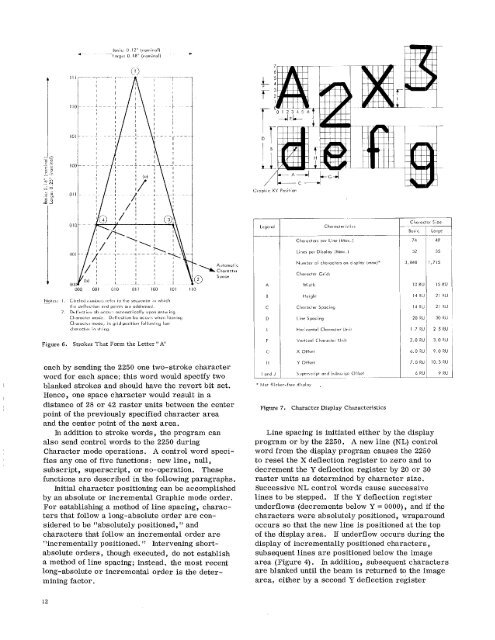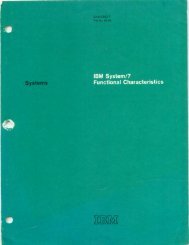IBM 2250 Display Unit Model 4 - All about the IBM 1130 Computing ...
IBM 2250 Display Unit Model 4 - All about the IBM 1130 Computing ...
IBM 2250 Display Unit Model 4 - All about the IBM 1130 Computing ...
Create successful ePaper yourself
Turn your PDF publications into a flip-book with our unique Google optimized e-Paper software.
:Basic: 0.12" (nominal)<br />
- large: 0.18" (nominal)<br />
rim<br />
4■<br />
(I)<br />
A<br />
4 ■/ iii.<br />
Or<br />
•E►<br />
r 1<br />
0 I 2 3 4 5 6<br />
E 4--<br />
1411P A■<br />
v<br />
k •<br />
I 10<br />
A<br />
Nom<br />
'Al<br />
D<br />
MEM I up...<br />
ral<br />
gh,••o<br />
Graphic XY Position<br />
Legend<br />
Character Size<br />
Characteristics<br />
Basic Large<br />
Characters per Line (Max.) 74 49<br />
Lines per <strong>Display</strong> (Max.) 52 35<br />
Number of characters on d.sploy (max)* 11,848 1,715<br />
Character Grid:<br />
A Width 10 RU 15 RU<br />
I. Circled lill1111,1L refel to <strong>the</strong> SC(4,...11", in which<br />
<strong>the</strong> deflection end points ale addressed.<br />
2 Deflect ion oh occuts automatically upon entering<br />
Character mode. Deflection ba occurs when leaving<br />
Character mode, in grid position following lost<br />
character in sh ;lig.<br />
Figure 6. Strokes That Form <strong>the</strong> Letter "A"<br />
each by sending <strong>the</strong> <strong>2250</strong> one two-stroke character<br />
word for each space; this word would specify two<br />
blanked strokes and should have <strong>the</strong> revert bit set.<br />
Hence, one space character would result in a<br />
distance of 28 or 42 raster units between <strong>the</strong> center<br />
point of <strong>the</strong> previously specified character area<br />
and <strong>the</strong> center point of <strong>the</strong> next area.<br />
In addition to stroke words, <strong>the</strong> program can<br />
also send control words to <strong>the</strong> <strong>2250</strong> during<br />
Character mode operations. A control word specifies<br />
any one of five functions: new line, null,<br />
subscript, superscript, or no-operation. These<br />
functions are described in <strong>the</strong> following paragraphs.<br />
Initial character positioning can be accomplished<br />
by an absolute or incremental Graphic mode order.<br />
For establishing a method of line spacing, characters<br />
that follow a long-absolute order are considered<br />
to be "absolutely positioned," and<br />
characters that follow an incremental order are<br />
"incrementally positioned." Intervening shortabsolute<br />
orders, though executed, do not establish<br />
a method of line spacing; instead, <strong>the</strong> most recent<br />
long-absolute or incremental order is <strong>the</strong> determining<br />
factor.<br />
B Height 14 RU 21 RU<br />
C Character Spacing 14 RU 21 RU<br />
D Line Spacing 20 RU 30 RU<br />
L Horizontal Character <strong>Unit</strong> 1.7 RU 2.5 RU<br />
F Vertical Character <strong>Unit</strong> 2.0 RU 3.0 RU<br />
C X Offset 6.0 RU 9.0 RU<br />
II Y Offset 7.0 RU 10.5 RU<br />
I and J Superscript and Subscr ipt Offset 6 RU 9 RU<br />
1." Not flicker-free display<br />
Figure 7. Character <strong>Display</strong> Characteristics<br />
Line spacing is initiated ei<strong>the</strong>r by <strong>the</strong> display<br />
program or by <strong>the</strong> <strong>2250</strong>. A new line (NL) control<br />
word from <strong>the</strong> display program causes <strong>the</strong> <strong>2250</strong><br />
to reset <strong>the</strong> X deflection register to zero and to<br />
decrement <strong>the</strong> Y deflection register by 20 or 30<br />
raster units as determined by character size.<br />
Successive NL control words cause successive<br />
lines to be stepped. If <strong>the</strong> Y deflection register<br />
underflows (decrements below Y = 0000), and if <strong>the</strong><br />
characters were absolutely positioned, wraparound<br />
occurs so that <strong>the</strong> new line is positioned at <strong>the</strong> top<br />
of <strong>the</strong> display area. If underflow occurs during <strong>the</strong><br />
display of incrementally positioned characters,<br />
subsequent lines are positioned below <strong>the</strong> image<br />
area (Figure 4). In addition, subsequent characters<br />
are blanked until <strong>the</strong> beam is returned to <strong>the</strong> image<br />
area, ei<strong>the</strong>r by a second Y deflection register<br />
12
















